No Results Found
The page you requested could not be found. Try refining your search, or use the navigation above to locate the post.


The Anne Fransen Fund (AFF) of Consumers International was founded in 1988 following the death of Anne Fransen, the first director of Consumers International member organisation, Consumentenbond in 1981. The main aim of the fund is to promote and support the growth of consumer organizations in developing countries.
Consumer Voice was one of the seven Consumers International members that promoted the protection of consumers around the globe through the funding provided by the AFF2017.
Consumer VOICE trained a group of consumer activists on digital economy who will then carry the mission forward.
The overall objective of Digital Literacy Initiative is to empower the vulnerable consumer group on digital issues so that they may effectively explore the opportunities provided by digitally empowered knowledge economy. ‘Be safe yet be digitally empowered’, is the message that is given through the project. Some of the important goals of Digital Literacy Initiative include:
For the pilot project we chose National Capital Territory of Delhi which includes New Delhi and urban areas surrounding it in neighbouring states of Haryana, Uttar Pradesh and Rajasthan as it is one of India’s world’s largest agglomerations, with a population of around 5 crore. We chose the project area due to factors like the largest number of targeted consumers, lack of digital literacy, and high rate of cyber crimes. Apart from this due to our presence and strengths in NCT, there are more chances of creating maximum impact in given budget and time.
The following steps were taken to implement the project:
A single day ToT workshop for consumer activists (30 in all) were trained on digital issues where intensive training on issues related to handling of digital devices and safe internet usage were imparted.
DEVELOPED AND DESIGNED TRAINING MODULES FOR TOT & DIGITAL LITERACY CAMPS CONSUMER
Consumer VOICE created digital literacy awareness material and dedicated pages on social media platform to maximize reach and ensure engagement of all stakeholders.
Consumer Voice organised six Digital Literacy camps across NCR with different categories of vulnerable consumer groups such as youngsters, women, and elderly. The purpose of these camps is to make them digitally literate to boost their confidence to join the digital economy and society.
Consumer Voice helped consumers in redressal of their complaints related to digital issues. This was a continuous activity and continued even after the project duration.
Consumer VOICE implemented this project with the help of local partners for on-field activities. Government and regulatory agencies were involved to advocate for better policy decisions and strict enforcement and monitoring mechanism.
The page you requested could not be found. Try refining your search, or use the navigation above to locate the post.


Consumer Voice, a New Delhi based non-profit organization that works to spread consumer awareness organised a workshop on Electronic Waste or e-waste in its office on 13th March 2019. This workshop was part of World Consumer Rights Day (WCRD) which is celebrated on 15th March every year. The theme of WCRD 2020 was ‘Sustainable Consumer’. Like a trustworthy whistle-blower on the matter related to consumer education and awareness, the focus of the workshop was on educating consumers on responsible e-waste disposal.
Ashim Sanyal, COO at Consumer VOICE introduced the subject to the gathering and shared his views on the same. Satish Sinha, Associate Director at Toxics Link addressed the gathering of professionals from diverse backgrounds.
Mr Sinha spoke on the lack of responsible e-waste disposal in our country and the right to repair our electronic gadgets among others. He said India is unlike the other countries where consumers enjoy the #righttorepair. A consumer in those countries can go to the manufacturers and ask for a certain product to get repaired. In India, he cited the example of the OEM (Original Equipment Manufacturer) industry in particular due to whom the consumer after using a car or certain electronic product for certain years, can’t repair such products when the need appears. In most of the cases, the manufacturer shows the non-availability of spare parts. In such a scenario, the consumer facing such a situation compels to buy a new product instead of getting the product repaired. One can very well understand how this results in the accumulation of e-waste.

Likewise, mobile manufacturing companies are also responsible for not encouraging consumers on using repaired products, rather they encourage consumers to buy new products.
Sinha also spoke about how the CFL light manufacturing industry was using mercury in the CFL lights in India. Sinha cited the examples of several developed countries where they have a stringent regulation of using only 5 ml mercury per CFL light. Here in India, the mercury usage was much higher at around 15-20 liter per CFL. However, the scenario is much better now with adequate intervention.
Elaborating the need for sustainable consumption Sinha said, “As a responsible consumer we all have to contribute towards responsible disposal of e-waste and demand for the rights which are not in existence particularly in India such as the right to repair. He also stressed the need for regulation to tackle the problem of e-waste disposal thus contributing towards a sustainable future.”
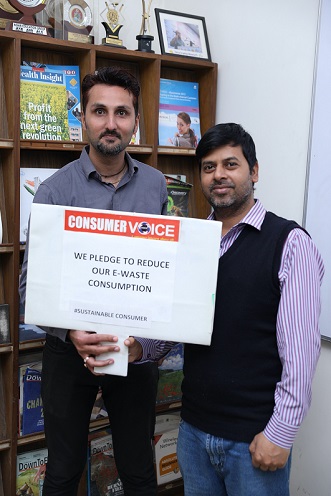
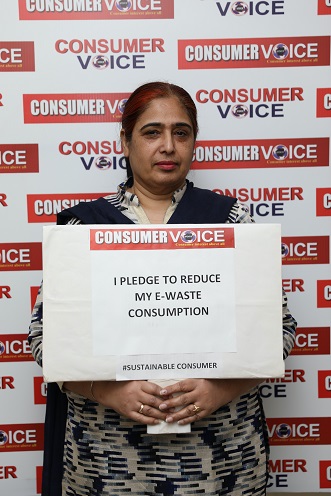


In the era being described as “Digital India”, it is important to increase the internet penetration but it is also important to improve the quality of internet services to be able to realize the goal of “Digital India”. Having taken the first step of getting connected, quality of services cannot be ignored and is the necessary second step that needs to be taken.
VOICE initiated a study on ‘Assessment of Impact of Quality of Internet Services on Internet Users’, in September 2016, supported by Ford Foundation, which was based on a sample of 52,000 across 19 states of India. The purpose of this study was to assess the impact of quality of internet services delivered to its consumers. It found several shortcomings/impediments which require attention for further enhancing quality of internet.
Assessment Of Impact of Quality of Internet Service is a national study under taken by Consumer VOICE to assess the:
‘NeedQoIS’ is an initiative taken by VOICE in the interest of internet users (consumers) to educate and enlighten them about Quality of Internet Service (QoIS) and engaging consumers in the fight for better internet service nationwide to make it a truly Digital India. (For more details, please visit https://www.facebook.com/NeedQoIS/)
The study, besides seeking perceptions on various parameters of quality of internet, sought perceptions on the impact of internet on various aspects of life, which include daily lives, development of rural areas, education and research, business and jobs, health and medical services, political and civic participation, shopping, travelling and commuting, women empowerment and empowerment of people with special needs, and e-governance. It was found that each of these aspects is significantly impacted by internet.
The measurement of wireless internet speeds in this study was also undertaken. The average 3G speeds were only 1.5 mbps while average 4G speeds were only 4.10 mbps. These are among the lowest in the world. By definition, 4G speeds are 40 to 150 mbps and Indian telecom companies, claiming use of 4G technology are delivering 3G speeds to their customers.
Based on the study, following recommendations were made to TRAI –

This work is licensed under a Creative Commons Attribution 4.0 International License.
Consumer VOICE celebrated World Consumer Rights Day (#BetterDigitalWorld) at Bangalore by organizing a workshop in collaboration with the The Chair on Consumer Law and Practice, National Law School of India University. Prof. (Dr.) R. Venkata Rao, Vice Chancellor, NLSIU was the Chief Guest. Prof Sriram Khanna, Consumer VOICE and Prof.(Dr.) Ashok R. Patil, NLSIU were the expert speakers who discussed and explained the findings of this national study. Read More
Consumer VOICE Conversation Series held 18 Dec’17 aimed at enlightening consumers about the quality of internet services and also to awaken the concerned authorities to take the appropriate action to improve the quality of internet service in India under the initiative – NeedQoIS. The event also had officials from TRAI (Telecom regulatory Authority India) to present their point of view and answer the questions and issues raised by the audience.
Big Tobacco Tiny Targets Study - Gujarat workshop Big Tobacco-Tiny Targets Study-Rajkot Workshop Consumer VOICE in collaboration with its state partner Rajkot Saher Jilla Grahak Suraksha Mandal Rajkot, Gujarat organised a stakeholders’ workshop on July 24, 2021 at...
Internet Speed – Where is the Speed?It’s an irony that while writing this blog on internet speed, work was hampered several times because of slow internet speed. At a time when India is trying to make headway as Digital India, people in India are still struggling over...


Safer Cars in India is an initiative of Consumer VOICE as part of a global campaign for safer cars by Consumers International. Consumer VOICE organized 15 workshops in the months of June and July, 2017, across India to demand for safer cars for consumers in India. The pan-India campaign took place across 15 states from Jammu and Himachal Pradesh to Assam and Odisha which was aimed to reach out to over 5000 consumers.
When the world is making a shift to automated cars, Indian cars still lack in basic safety features like airbags, Antilock Braking System (ABS) and Electronic Stability Control (ECS). In order to demand for safer cars in India, Consumer VOICE organized workshops across India with the following objectives:
All of the consumer empowerment workshops started with a five minute film highlighting the real experiences of car crash victims, their relatives, and the trauma they have gone through and message they want to convey to all the
consumers, manufacturers and Government.Presentations were made by road safety experts, automobile experts and educated consumers on various road safety aspects and the need for safer cars. Throwing some light on the alarming figures on road traffic crashes,
Mr. Ashim Sanyal, COO, Consumer VOICE, during one of the workshops said,
“As per Indian Government figures, approximately 146,133 people were killed in road accidents in 2015 alone – averaging an alarming 1,374 crashes per day. Apart from reckless driving, a crucial component to road safety is safer vehicles on our roads. The worrisome part is that, despite being the world’s 4th largest automobile market, almost 60% of the cars sold in India aren’t equipped with basic safety features such as airbags and ABS, which can protect lives of car occupants in a crash." He further elaborated on the issue of safer cars as 5 popular Indian cars received a zero-star rating in GNCAP results. Zero-rated cars being bought and sold in India is a cause of concern often overlooked.”
The page you requested could not be found. Try refining your search, or use the navigation above to locate the post.


267 million tobacco users in India.
Among people above 15 years, 28.6% of the population currently uses tobacco products
Among youth (ages 13-15 years), 14.6% currently use some form of tobacco (boys 19.0%; girls 8.3%) and 4.4% smoke cigarettes and 12.5% use other tobacco products.
12.1% of daily users of smokeless tobacco aged 20-34 had started using smokeless tobacco when they were younger than age 15 and 36.2% of daily smokeless tobacco users aged 20-34 had started smoking or started smokeless tobacco use when they were minors i.e. younger than 18 years.
The prevalence of tobacco use varied across the states/UTs from 64.5% in Tripura to 9.7% in Goa. The mean number of cigarettes smoked per day by a daily cigarette smoker was 6.8 and the mean number of bidis smoked per day by a daily bidi smoker was 15.1.
Tobacco use is a major risk factor for the four main Non-communicable Diseases (NCDs) — cardiovascular disease, cancer, chronic lung disease and diabetes, which puts people with these conditions at higher risk for developing severe illness when affected by COVID-19. Smokers are likely to be more vulnerable to COVID-19 as the act of smoking means that fingers (and possibly contaminated cigarettes) are in contact with lips which increases the possibility of transmission of virus from hand to mouth. Experts have confirmed that smokers are more likely to develop severe symptoms or die from COVID-19, as it primarily attacks the lungs. Further smoking products such as water pipes or hookah often involve the sharing of mouth-pieces and hoses, which could facilitate the transmission of COVID-19 in communal and social settings. Read more
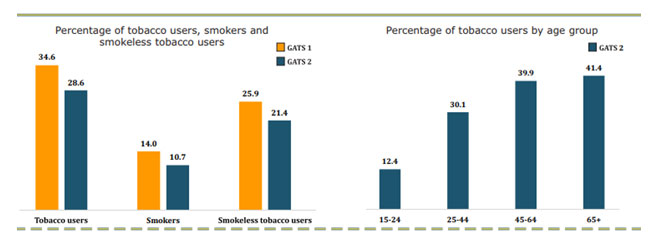
(Source : Ministry of Health and Family Welfare)
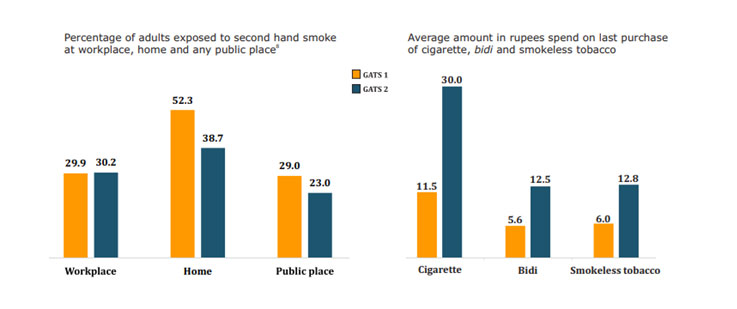
(Source : Ministry of Health and Family Welfare)
The Parliament of India passed the “ Prohibition of Electronic Cigarettes (Production, Manufacture, Import, Export, Transport, Sale, Distribution, Storage, and Advertisement) Bill, 2019” by voice vote and with long discussion in both the houses (Lok Sabha & Rajya Sabha). Read More
The Global Adult Tobacco Survey (GATS) is a global standard for systematically monitoring adult tobacco use (smoking and smokeless) and tracking key tobacco control indicators.
GATS-1 was conducted between June 2009 and January 2010. The second survey was conducted between August 2016 to February 2017. It was conducted by Union Health & Family Welfare Ministry and Tata Institute of Social sciences. Comparing GATS-1 with GATS-2 we found an overall reduction in tobacco consumption at national level by 6% which is a very good news.
Tobacco products are easily available at every nook and corner. Easy availability is causing an increased use of tobacco and tobacco related products among all sections of the society. The harmful effects of tobacco are not unknown and therefore there is an urgent need to decrease the use of tobacco.
So, one of the important steps taken towards this is vendor mapping in various states with support from network of state partners.
Another effort of Consumer VOICE is sensitization of stakeholders through evidence based data to have laws to facilitate selling of tobacco through licensed shops so that one can put a curb on the mushrooming of tobacco stores everywhere.
Consumer VOICE is also working towards tobacco intervention focused on youth and children.
Shops authorized for selling tobacco products cannot sell any non-tobacco products such as toffees, candies, chips, biscuits, soft drinks, etc., which are essentially meant for non-user, especially children.
It is also ensuring no tobacco shops within 100 yards of any educational institution.
Sensitization of various stakeholders such as media, consumers and people working for the social cause through educational workshops and events.
A series of strong actions have been taken at both the national and state level to curb the country’s enormous tobacco epidemic, which claims one million lives each year. These actions include large, graphic warning or pictorial warning that cover 85 percent of tobacco products. India’s warnings are among the largest in the world, showing that graphic warnings depicting the deadly consequences of tobacco use work to help current users quit and prevent people from starting to use tobacco.
To prevent use of tobacco it has to be a joint effort of the government and the people. The government is doing its bit by forming several legislations like banning smoking in all public places, prohibiting advertisement and promotion of all tobacco products and sale of tobacco to minors.Quit Today,’ a toll free helpline number (1800-11-2356) to be printed on all tobacco products.
Ashim Sanyal, COO Consumer Voice welcomed the decision of the Health Ministry and said that the “Health Ministry has implemented from April 2016, large pictorial health warnings occupying 85 percent on both sides of all tobacco packages of cigarettes, bidis and all forms of chewing products. He also said said that the vendor licensing is an effective way to manage random sale of tobacco products and aims at controlled sales through registered vendors.”
Cigarettes and Other Tobacco Products (Prohibition of Advertisement and Regulation of Trade and Commerce, Production, Supply and Distribution) Act, 2003 or COTPA 2003 prohibits advertisement of and sale and supply of cigarettes and other tobacco products in India. The Ministry of Health and Family Welfare took up several initiatives to create awareness about the harmful effects of tobacco use and tobacco products out of which pictorial warning is a hugely successful one.However, the key to success is the implementation of these measures.
Cigarettes and Other Tobacco Products (Prohibition of Advertisement and Regulation of Trade and Commerce, Production, Supply and Distribution) Act, 2003
Various Sections are hereunder: –
The specified health warning shall cover at least 85% of the principal display area of the package of which 60% shall cover pictorial health warning and 25% shall cover textual health warning and shall be positioned on the top edge of the package and in the same direction as the information on the principal display area.The tenure of the existing health warning was to end on March 31, however, the Government has extended the duration of existing health warnings on tobacco packs till August 31.
The Ministry of Health and Family Welfare, Government of India has notified new sets of specified health warnings for all tobacco product packs by making an amendment in the Cigarettes and other Tobacco Products (Packaging and Labelling) Rules, 2008 vide GSR 592 (E) dated 21st July, 2022 “The Cigarettes and other Tobacco Products (Packaging and Labelling) Third Amendment Rules, 2022”. The amended Rules will be applicable w.e.f. 1st December, 2022.
The new set of specified health warnings shall be-
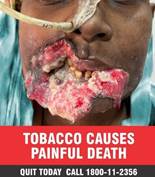

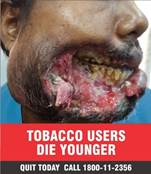
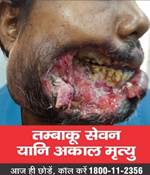
In view of the above, it is informed that;
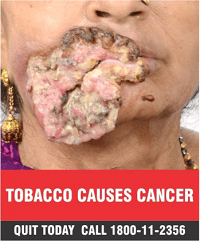
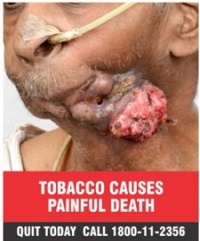
July 2, 2019 | Business Standard
Several civil society groups across India lauded the ongoing efforts of the government … Read more
May 31, 2019 | ET HealthWorld.com
Even as the union health ministry continues its efforts to prevent the entry of e-cigarette …. Read more
May 31, 2019 | Health Issue India
The controversy over the e-cigarette industry in India shows no signs of abating as …. Read more
Big Tobacco Tiny Targets Study - Gujarat workshop Big Tobacco-Tiny Targets Study-Rajkot Workshop Consumer VOICE in collaboration with its state partner Rajkot Saher Jilla Grahak Suraksha Mandal Rajkot, Gujarat organised a stakeholders’ workshop on July 24, 2021 at...
Big Tobacco, Tiny Targets Study 2020On 12th January, on the occasion of Swami Vivekanada’s birth anniversary, which is also celebrated as National Youth Day, the report of Big Tobacco, Tiny Targets Study 2020 was released online. The study was conducted across 1011...
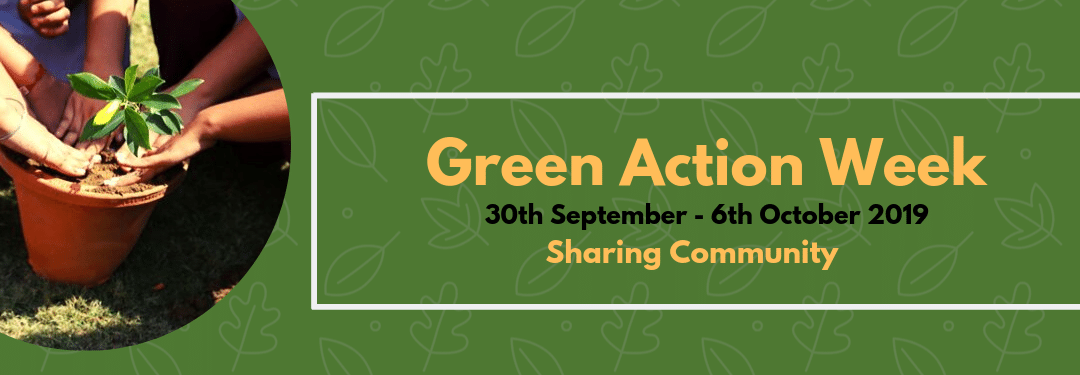

Green Action Week (GAW) is a global campaign held every year in October. It is an initiative by the Swedish Society for Nature Conservation (SSNC) and is carried out in coordination with Consumers International (CI). The theme of Green Action Week in 2019 is Sharing Community, extension of the same theme that was in 2018.
To ignite cultures of sharing and collaboration and to make sure everyone has sustainable access to goods and services. This time too Consumer VOICE is participating in the campaign through Community Sharing. Providing clear air to all is the main objective of Consumer VOICE this time, as we all know that with each passing day pollution level is rising to new heights and there is deep lack of clean and pollution free air in Delhi. The need to inculcate green practices is greater than ever before. We need to breathe clean and help others breathe as well.

Not all people have equal access to the goods and services needed a decent life, and too much stress is being put on the planet. Green Action Week therefore focuses on sustainable consumption because it is crucial to tackle both the social and environmental causes of this crisis.
Through Green Action Week, Consumer VOICE wishes to reinforce the culture of sharing and giving it back to the community. One of the best tools in the fight against air pollution through community sharing is planting of trees and preserving them. Communities including school students, members of Resident Welfare associations, and women together can make a difference. A small step taken by all will result in a big change.
Last but not the least, gift a plant to preserve the environment!
Pollution level in Delhi is nothing new to the world. As per one of the studies, air pollution in Delhi is responsible for approximately 10,000 to 30,000 deaths in the city. This means the capital city loses 80 lives every day to pollution from PM 2.5. Planting of trees /anti pollution plants is one of the effective measures to tackle the problem of pollution and step towards sustainable environment.According to the latest data compiled in the IQ Air Visual 2018 World Air Quality Report and interactive world’s most polluted cities ranking, which is prepared in collaboration with Greenpeace Southeast Asia in order to reveal the state of particulate matter (PM2.5) pollution in 2018, Delhi had an average yearly PM2.5 concentration at 113.5 micrograms per cubic metre. The report is based on air quality data collected in 2018 from public monitoring sources, with a special focus on data which has been published in real-time or near real-time.

Green Action Week Workshop in Rajpur Khurd village As part of Green Action Week, the residents of Rajpur Khurd village joined hands by planting air...